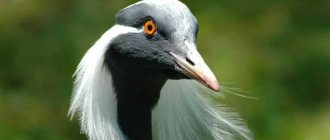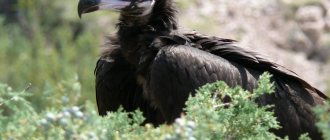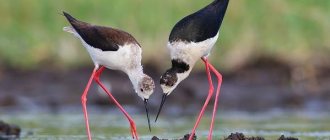| Latin name: | Gruidae |
| Kingdom: | Animals |
| Type: | Chordata |
| Class: | Birds |
| Squad: | Crane-like |
| Family: | Cranes |
| Genus: | Bustards |
| Height: | 90-180 cm |
| Wing length: | 75-115 cm |
| Wingspan | 150-230 cm |
| Weight: | 2-8 kg |
What does it look like
— Advertising —
The crane is about to fly
Cranes are beautiful, stately birds. They are distinguished by long thin legs, a high slightly curved neck, a small head and an elongated sharp beak. The body is positioned horizontally relative to the ground. The tail is usually long and densely feathered. The areas around the eyes are bare. The wings of a crane are wide, long, and blunt at the end.
The crane flapped its wings
The plumage of birds contains black and white colors. In some species they are complemented by brown, bluish, and yellow tones. There are often yellow and red markings on the head.
— Advertising —
Two cranes on a walk
Those cranes that feed on aquatic life have wider toes, and a longer beak and neck than birds that live in steppe areas and feed on terrestrial game. The head of some species of cranes (the crowned crane and the eastern crowned crane) is decorated with a crest of thin golden feathers sticking up.
general description
Cranes are very numerous and diverse, but they have basic common features. Females and males are almost indistinguishable from each other, apart from a slight difference in size.
Appearance of a crane
All cranes have a large body, a long curved neck and long legs. Height ranges from 90 to 160 cm, and the wingspan is from 1.5 to 2.4 m. The smallest crane is the demoiselle crane, weighing about 2 kg, and the largest are the Australian and Japanese, up to 11 kg.
The small, neat head is a smooth continuation of the neck and ends with a long straight beak. It is very sharp, which helps the bird to hunt masterfully. Many species have bald patches of rough skin on their heads. The tail appears long, but in fact it is elongated flight feathers in folded wings.
Photo: placepic.ru
Cranes, storks and herons: differences
Given their apparent similarity, a heron and a crane are easy to distinguish in flight. The fact is that cranes stretch their necks and legs, which ultimately makes them much more similar to storks. But, unlike storks, cranes do not perch on poles and trees. The body of cranes looks thinner and more graceful than that of storks, and the beak is smaller. Their legs and neck are longer than those of a heron.
Photo: o-prirode.ru
How long do cranes live?
Cranes are real long-lived birds. Even in the wild, they easily live up to 20-25 years or more, and in favorable conditions in captivity their age reaches 80 years.
Photo: fonwall.ru
Story
Cranes are considered one of the most ancient bird families, which formed at the end of the era of dinosaurs. Their historical homeland is America, and from there they spread throughout the world. There are many cave paintings and other evidence that ancient people were very familiar with cranes.
Photo: khersonci.com.ua
Spreading
Cranes in a meadow
There is an opinion that initially cranes lived only in North America, but gradually scattered across all continents. Today they live everywhere, with the exception of Latin America and Antarctica. In Russia, 7 species of cranes nest and migrate. The most well studied is the Gray Crane, whose population is the most numerous in our country.
Interesting facts about the bird
The gray crane has been revered since ancient times. Rock paintings of a crane have been preserved; the age of the drawings is 50-60 thousand years. In Ancient Egypt, the bird was used in religious rituals and sacrificed to the gods.
Features of the species:
- the gray crane nests only in Eurasia, mainly in Scandinavia and Russia;
- during the breeding season, for camouflage, males and females stain their feathers in silt and dirt, merging with the surrounding nature;
- in flight, representatives of the species stand up straight, but when a cold front approaches, they tuck their legs;
- One of the most famous indoor plants, geranium, is named after the species.
The Gray Crane is a beautiful and endangered bird. The actions of people working in nature reserves and sanctuaries help preserve the population.
Habitats
Photo of a crane near a pond
Cranes live in open areas near fresh water bodies. Floodplain meadows and swampy areas are chosen for nesting. The habitat of sandhill cranes is salt lakes. Belladonna and crowned bird species live in the steppes. The black crane lives in the swamps of the taiga, inhabiting areas with dense woody vegetation. Many cranes live close to humans and settle near cultivated fields.
What is WWF doing to protect cranes?
This is where WWF makes significant efforts to conserve cranes and their habitats. First of all, through the creation and maintenance of protected areas that preserve wetlands and meadows. Now in the Amur basin there are only about 4 million hectares of “crane” territories under protection, which are supported by the Foundation, and approximately 2.5 million of them were created with the support of WWF. The second important area of activity is assistance to groups that extinguish fires in the habitats of cranes and storks and support for state anti-poaching teams.
As part of the Year of the Crane, the foundation will focus its efforts on continuing to develop and strengthen the network of crane protected areas, study the current abundance and distribution of cranes, involve the public in the conservation and study of rare birds, and work with agricultural producers to prevent deterioration in the quality of the cranes’ habitat during agricultural activities.
Migratory bird or not
Flight of the crane
Nine of the fifteen species of cranes are migratory birds . In autumn, mainly in mid-September, birds gather in flocks and fly away to the southern regions for the winter. Cranes nesting in the European part of Russia winter in southern Europe (Spain) and northern Africa (Algeria, Morocco). Birds that live in western Siberia winter in India. Oriental cranes migrate to southern China during cold periods. Far Eastern bird families fly to Southeast Asia.
Photo of cranes in the sky
Six of the fifteen species are sedentary. Some cranes make seasonal migrations within their range. Depending on weather conditions, birds make daily or seasonal migrations. During the rainy season, cranes fly 500-600 kilometers to where there is no precipitation, then return back to their nesting sites.
Where does the gray crane live?
Photo: Gray crane bird
The nesting sites of gray cranes are located in Europe (northeast) and Asia (north). Birds usually winter in Africa (north), Pakistan, Korea, India, Vietnam, and the Iberian Peninsula. The birds' habitat preferences include heavily moist areas of swamps, freshwater rivers and lakes. They especially like to settle near alder groves. In search of food, cranes quite often visit pastures and arable lands.
Gray cranes are migratory birds. Twice a year - in autumn and spring, they fly vast distances from nesting sites to wintering sites and back, which requires large energy expenditures. For this reason, at the end of summer, cranes in large numbers (up to several thousand individuals) gather in safe places and rest, gaining strength before departure. Such safe places can be: islands, sand spits, deep swamps.
In the mornings, the birds gather in a wedge and fly to their feeding places, and in the evenings they still return to roost in the same wedge. During this period, the birds are practically not bothered by the presence of people in the fields or the presence of various equipment. It is at this time that you can see them quite close and also hear their voices. At the end of August in the northern regions and at the beginning of October in the southern regions, cranes migrate south. Having wide wings, birds use a flight strategy in which they catch warm air currents (thermals), allowing them to save strength and energy as much as possible.
The flight of cranes to the south is an interesting spectacle: a flock suddenly takes off, begins to circle, emitting purrs, rises higher and higher on air currents, forms a wedge until it completely disappears in the sky.
Now you know where the gray crane lives. Let's see what he eats.
Voice of the Crane
A crane bathes in a lake.
The sounds made by a crane are similar to the murmur of a mountain stream or the sound of a musical instrument. At different times of the year, birds loudly cry out the ringing “kur-ly - kur-ly”. Cranes always sing in a duet - one bird begins the song with the syllable “kur”, and the second takes up “ly”. When birds sing in tandem, the result is a continuous melody in which the word “kurly” can be clearly heard. If a bird calls alone, it makes only the sound of “churns.”
During the mating season, females and males sing drawn-out melodic songs with a combination of syllables “skoko-ko-sko-sko-skoko-ko”. The song is sung at sunrise and fades away as dusk approaches.
Lifestyle
A crane flies over a swamp.
Cranes are diurnal birds. As the sun rises, the birds begin searching for food. As soon as the sun's rays disappear behind the horizon, the birds fall asleep. They sleep standing on one leg in the middle of shallow water. Cranes are very careful birds. While the whole flock is feeding, several birds are guarding the family, watching the area. They can smell strangers at a distance of three hundred meters. If they sense the approach of an animal or a person, they immediately fly away, accompanying their departure with furious screams.
The birds take off with a running start, the birds spread their wings, straighten their necks and jump off the ground. In flight, cranes stretch out in a straight line, which allows them to reach speeds of up to 65 kilometers per hour. During migration, birds fly tirelessly for several days. The flight altitude is one kilometer; the flock forms a wedge only when there is a headwind.
Cranes fly to warmer climes
Birds rest in marshy, quiet places. They can “stay” there for 7-10 days. Then the flock rises into the sky again and sets off on a long journey. Cranes never sit in trees or rest on land for their own safety - in water they have a better chance of not falling into the clutches of wild animals.
Cranes live in clusters; 100-200 pairs of birds coexist in one territory. The bird family chooses secluded places for nesting sites, away from noisy roads and cities.
Birds prefer to live in one place for years. After wintering, the cranes return to their old nests. These amazing birds are able to adapt to any weather conditions; they are not selective in food.
The crane stands thoughtfully near the water
Only a lack of food or a change in the environment can force birds to leave their home.
Cranes arrive at the end of February - early March. Having settled in the same place, the birds begin to reproduce. These birds are monogamous. Once they choose a partner, they stay with him forever. Cranes reach sexual maturity at four years of age. Family cranes wintering in southern countries migrate in pairs.
Nutrition
The crane is essentially an omnivorous bird The diet of such representatives of the bird kingdom depends largely on the variety, and, naturally, on the place of settlement of such birds, as well as on the time of year. However, it is very extensive.
Among plant foods, they eat potatoes, corn, peas, barley, they are very fond of wheat shoots, and they also eat wheat itself. Settling in swamps, they look for sprouts of a wide variety of swamp and aquatic plants, as well as berries.
Birds living near bodies of water are happy to include mollusks, snails, fish, and small invertebrates in their diet.
In the summer, larvae and adult insects are an excellent treat for cranes. Lizards and bird eggs are suitable for them to eat. Chicks from the crane family, which urgently require protein for normal growth, feed mostly on insects.
Reproduction
Mating dances of cranes
Mating rituals include choral songs and dances. Males, attracting females, perform sonorous songs. When singing, males stretch their necks and lift their heads so that their beak points to the sky. During the period of spring songs they say “The cranes are trumpeting the dawn.” The ringing voices of cranes herald the coming of spring.
Ritual bird dances look colorful. Mature birds run in a circle, flapping their wings and jumping funny on their stilt legs. During the dance, they make loud, sharp sounds ending in a dull consonant “rkak-kak-karrs”. From two to seven birds take part in the dance.
Nest
Crane eggs in a nest
Both partners are involved in the construction of the nest. The nesting site is made on the ground, in the thicket of plants. The nest is made from dry thin branches and twigs, tying them together with blades of grass. The finished house is a wide, shallow bowl. Birds live in one nest for several years. Every year, after wintering, the birds repair their home and settle in it again.
Natural enemies
Birds have a lot of natural enemies, but adult birds are considered quite intelligent and cautious, and therefore rarely fall into the clutches of predators. Most often, their victims are still fragile chicks, who are attacked by predators who destroy the nests of cranes, eating their eggs and offspring. Thus, nest destruction and hunting can be carried out by:
- Eagles.
- Hawks.
- Foxes.
- Golden Eagles.
- Boars.
- Wolves.
Adult birds practically do not allow themselves to be caught by surprise, since they are quite large, fast-flying and cautious. Whenever a threat appears, they give a loud sound signal, warning their relatives of the danger.
One of the main enemies is the hawk
If predators find themselves close to a couple’s nest in which the offspring lives, one of the parents tries to take it away from there. This happens by simulating a wound, with which the crane distracts the attacking enemy.
In addition to wild animals, the crane population is also threatened by human activities. Due to human actions, the natural habitat of birds is being destroyed, as a result of which they are forced to migrate, looking for new places for food and nesting. People often drain swamps to get new land for farming. This drives birds away from their homes.
In addition, cranes often encroach on sown fields: the birds eat young shoots of grain crops. In temperate climates this is usually not a problem as there is plenty of plant and animal food in the area. However, in Africa, where the climate is hot and dry, there is much less food, which poses a threat to life. Because of this, cranes often raid farms, while farmers themselves try to drive the birds away. Often this ends in the targeted destruction of birds, despite the fact that formally shooting cranes is prohibited.
Crane chicks
The crane chick has just hatched from the egg.
There are two eggs in the crane clutch. Some species have 4-5 eggs. Cranes living in the north have dirty yellow eggshells. Southern birds lay white and light blue eggs. The eggs of all types of cranes invariably have a dark brown pigment spot.
Photo of a crane chick in human hands
The offspring are hatched by both parents in turn. The incubation period lasts 28-31 days. The chicks appear already pubescent; by 28 days they have plumage. The color of the feathers of young cranes is red; only by the age of two years the color becomes identical to adult cranes. The cubs see well, are quite active and take their first steps within 7-10 days. Nature arranges it in such a way that hatched cranes immediately become rivals. The stronger and more mature chick tries to push its brother or sister out of the nest or strangle it. By two weeks, the competitive instinct disappears.
Crane mother and chicks
Adult birds feed the crane chicks for three months. By 30 days of life, the chicks begin to fly. The young leave the parental nest at the age of 2-2.5 months.
What do cranes eat in the wild?
Cranes are omnivorous birds that eat both plants and small animals. Plant food sources for them include grass, seedlings, leaves, plant roots, seeds, and tubers. Cranes are also partial to legumes, cereals, and berries.
They especially prefer potatoes and corn. Food of animal origin is most often obtained by adults for their offspring. The chicks are fed:
- Worms.
- Snails.
- Insects.
- Shellfish.
- Crustaceans.
Adult cranes may also feed on lizards and toads.
Kinds
The crane family includes four genera and 15 species. Some scientists also include railing cranes and trumpeters in the crane family. However, according to the international classification, these species belong to other families.
Sandhill crane (Grus rubicunda)
Sandhill cranes walk near the water
Appearance: the height of an adult male reaches 1.5-1.8 meters. Sandhill cranes have long grey-brown legs and a narrow, long grey-green beak. The plumage of the body is gray, with darkening on the wings. There is a red stripe on the nape, a black goiter, and orange eyes. Distribution: The sandhill crane lives in the eastern hemisphere south of the equator - in Australia, Indonesia, New Guinea.
Features: cranes of this species prefer to feed on tubers of cultivated plants.
Red-crowned crane (Grus japonensis)
Dances of Japanese cranes
Appearance: Japanese cranes weigh up to 9 kilograms, height – up to 130 centimeters. Red-crowned cranes are black and white. The body is completely white, the tail and the front of the neck are black. There is a red spot on the back of the head. The legs and eyes are dark gray, the beak is greenish-brown.
Distribution: Red-crowned cranes belong to the group of migratory birds. They nest in marshy areas in East Asia (Far East and Japan). They winter in China and Korea.
Mating season of red-crowned cranes
Features: the Japanese crane is a rare species listed in the Red Book. Other names: Ussuri crane or Manchurian crane.
Indian crane (Grus antigone)
Two Indian cranes are calling.
Appearance: The height of Indian cranes reaches 180 centimeters, and their body weight is 7-12 kilograms. The plumage of Indian birds is bluish. The neck is light gray, there are yellowish streaks on the wings, and the tail is smoky. The upper part of the neck, the back of the head and the sides of the head are red, the top of the head is dirty gray, the beak is gray, the legs are pink.
Distribution: Indian cranes live in Northern India and Southeast Asia. A small population lives in northern Australia.
Indian crane looking for food
Features: There are three subspecies of Indian birds with different morphologies
- a. antigone - distinguished by the presence of a collar of white feathers on the neck and white flight feathers.
- a. sharpii - birds have dark brown plumage.
- a. gilli is an Australian subspecies.
Extinct subspecies: G. a. luzonica is a Philippine subspecies.
Whooping crane (Grus americana)
Male and female whooping crane
Appearance: one and a half meter birds are painted white. Legs are grey-green. The face and crown are red-black, the long, sharp beak is dark gray.
Distribution: The species lives in North America. Leads a sedentary lifestyle. Inhabits open marshy areas with a lot of vegetation.
Whooping crane caught a fish
Features: the rarest species of cranes, listed in the Red Book. The population lives in protected areas of America.
Common crane (Bugeranus carunculatus)
Photo of the common crane
Appearance: Common cranes have a unique appearance - at the base of the beak there are two long, leathery, rough growths of red color - “earrings”. The feathers on the tail, underwings and upper back are black, the upper part of the body is white with black strokes. The legs are gray, the eyes are red.
Distribution: sedentary. Lives in Western and Southern Africa.
Features: The only one of the six African crane species that is most dependent on the availability of marshy habitats.
Common crane (Grus grus, or Grus communis)
Gray crane in flight
Appearance: the body is gray, the fluffy tail has brown and black shades. The front of the neck is dark gray. There is a red spot on the back of the head. The eyes are red. “Panties” - the upper feathered part of the legs - are light gray. The legs are black and the beak is light. The female gray crane is painted a monotonous gray color.
Distribution: The gray crane lives in Eurasia, wintering in the south of the continent, North Africa, India and Saudi Arabia.
Early winter and gray crane
Features: one of the most common species of cranes, but the number of gray birds is inexorably declining. The reason for this is the reduction of places suitable for nesting, the drying up of rivers and swamps.
Siberian crane or white crane (Grus leucogeranus)
Two Siberian Cranes in a meadow
Appearance: a medium-sized bird (height up to 140 centimeters, weight 5-8 kilograms), with a slender body, short legs and a short neck. The body plumage is white, the face is red, the legs are pale pink, and the beak is dark red.
Distribution: white cranes live in the northern part of Russia. Siberian cranes are endangered and are included in the international Red Book lists.
Siberian crane in the swamp
Features: Siberian cranes have an unusual beak - there are numerous teeth along the inner edge, with which the bird is able to catch slippery fish and pull out underground roots.
White-naped crane (Grus vipio)
Photo of a white-naped crane
Appearance: The body, tail and front of the neck are dark gray. The back of the neck and head are white. There are bare red areas around the eyes. The legs are pink, the beak is gray-green.
Distribution: White-naped cranes live in Mongolia, China, and South Korea.
Features: Rare species, number 4900-5300 birds.
Sandhill crane (Grus canadensis)
Sandhill cranes among tall grass
Appearance: sandhill cranes have a barrel-shaped body and long thin legs, and a short neck. The beak is thick and of medium length. The body color is brown. The neck is gray-green, the legs are black. The areas around the eyes are dark red. The average weight of the bird is 4 kilograms, height is 120 centimeters.
Distribution: Sandhill cranes live in northern America and Chukotka.
Features: the most numerous species of cranes. The size of the bird colony is 650 thousand birds.
Black-necked crane (Grus nigricollis)
The black-necked crane flapped its wings.
Appearance: birds with an elongated, horizontal body and a strongly curved neck. The body is painted gray, the head with neck and bushy tail are black. There are burgundy spots above the eyes. Legs and eyes are black.
Distribution: birds live in Tibet, China and India. They lead a sedentary life. Rarely found in the Alps.
Photo of a black-necked crane in early winter
Features: black-necked cranes are not afraid of people, so they often settle near human habitation.
Demoiselle crane, demoiselle or little crane (Anthropoides virgo)
Close-up photo of belladonna
Appearance: the smallest representative of the crane family. The weight of the bird does not exceed three kilograms, and the height of the crane is 85-90 centimeters. The plumage of the body is smoky. The feathers under the tail, on the neck and head are black. On the chest there is a lush tuft of long black feathers.
Distribution: There are six distinct populations of birds that live in 47 countries. The largest number of little cranes are observed in Russia, Central Asia, and Africa. Two dozen pairs of belladonna belladonnas nest in Turkey.
Belladonna near the pond
Features: The little crane, unlike its family members, prefers to live on open plains with dense vegetation.
Paradise crane, Demoiselle crane or Stanley's crane (Anthropoides paradiseus)
The paradise crane is looking for food.
Appearance: a meter-tall bird weighing 2-2.5 kilograms. She has a large head, a short narrow beak, an elongated body and a long drooping tail. Plumage color is all shades of gray.
Distribution: the paradise crane inhabits the southern regions of Africa, in particular 99% of birds live in South Africa, a small population nests in Namibia.
Paradise crane in an endless field
Features: African demoiselle winters in the mountains. In summer it nests on farmland.
Crowned crane (Balearica pavonina)
Crowned crane near the quarry
Appearance: stately birds are brightly colored - the upper body and neck are gray, the belly and lower back are black, the short tail is black. The upper part of the wings is white, there are yellow spots at the base, and a burgundy stripe along the rear edge of the wings. The crown is a fluffy thread-like tuft on the head – yellow in color. The goiter is red, the cheeks are white, the face is black. The short beak is gray, the legs are brown.
Distribution: The settled species lives on the western and eastern coasts of the African continent.
Something clearly angered the crowned crane
Features: The crowned crane has a long rear toe on its feet. Thanks to this structure of the paws, the bird can easily maintain balance while sitting on a tree branch.
Eastern crowned crane (Balearica regulorum)
Eastern crowned crane in flight
Appearance: birds up to 120 centimeters high, body weight – 3-4 kilograms. The plumage of the back and belly is gray-blue with a light neck. The ends of the wings are white. Brown and red feathers grow on the tail. An orange crown is located at the back of the head. Long legs are gray, short thick beak is black.
Distribution: The eastern crowned crane lives primarily in eastern Africa. Sedentary appearance.
Pair of Eastern Crowned Cranes
Features: most cranes lead a semi-nomadic lifestyle. Birds make seasonal migrations only within their habitat, flying closer to water bodies during drought.
Black-billed crane (Grusmonacha)
A black crane drinks water from the lake.
Appearance: the average height of the birds is 1 meter, body weight is 2.8-3.5 kilograms. The body is black, the neck and head are white. The forehead is black, the long thick beak is light brown. Legs are grey.
Distribution: a small population of black cranes (there are 9.5 thousand birds in the world) nests mainly in Russia. Small groups are found in China and South Korea.
Photo of a black crane in a swamp
Features: these birds lead a secretive lifestyle, nesting mainly in hard-to-reach areas of high-moor sphagnum bogs in the taiga. The black crane's nest was first discovered in 1974. A rare species, listed in the Red Book.
Siberian crane, or white crane
photo
The Siberian Crane, or white crane (Grus leucogeranus) is endemic to the northern territories of Russia. These are slender, very beautiful white birds of medium size: height up to 1.4 m, wingspan from 2.1 to 2.3 m, weight from 4.9 to 8.6 kg. It is difficult to distinguish males from females as they are very similar in appearance. A unique characteristic of Siberian Cranes is their serrated beak, which helps them catch slippery prey and feed on underground roots.











